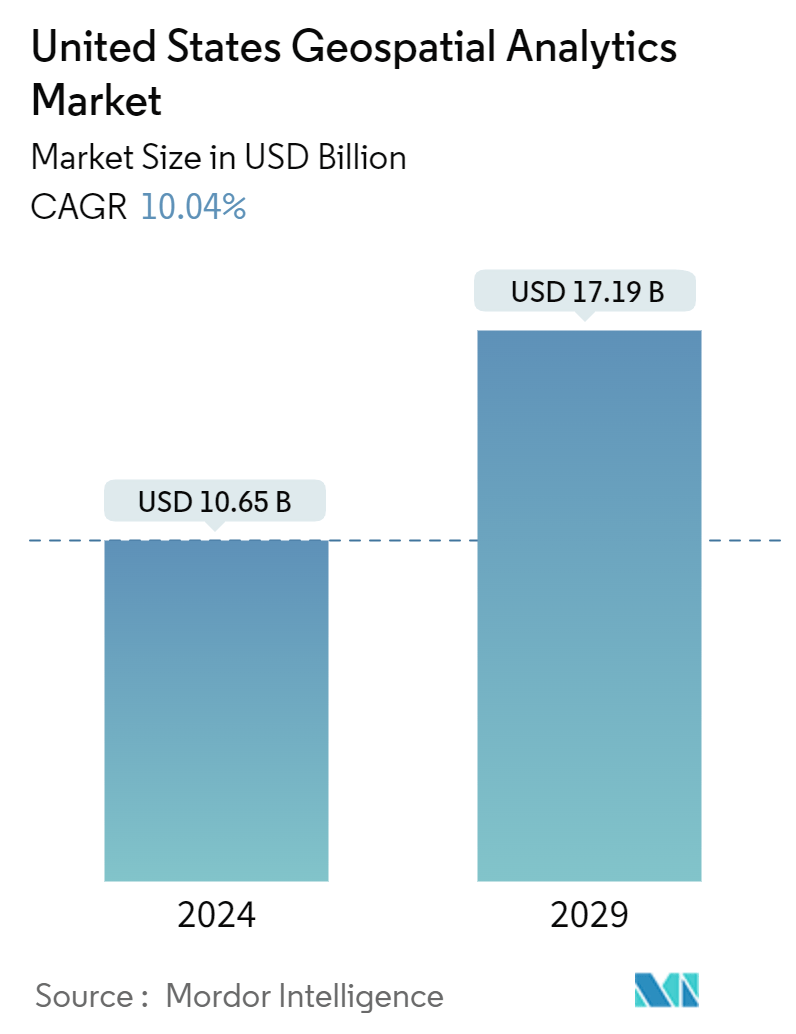Market Size of United States Geospatial Analytics Industry

| Study Period | 2019 - 2029 |
| Base Year For Estimation | 2023 |
| Market Size (2024) | USD 10.65 Billion |
| Market Size (2029) | USD 17.19 Billion |
| CAGR (2024 - 2029) | 10.04 % |
| Market Concentration | Medium |
Major Players
*Disclaimer: Major Players sorted in no particular order |
United States Geospatial Analytics Market Analysis
The United States Geospatial Analytics Market size is estimated at USD 10.65 billion in 2024, and is expected to reach USD 17.19 billion by 2029, growing at a CAGR of 10.04% during the forecast period (2024-2029).
Geospatial analysis refers to a broad range of activities that emphasize applying various techniques to data comprising geographical or space-related characteristics. The increasing use of GPS devices, technological advancements in the field of GIS technology, recent trends in the integration and convergence of geospatial technologies, the emergence of new business models aimed at leveraging the demand for geospatial information, and the increased application of geospatial analytics in city and town planning are some of the primary factors driving the expansion of the market for geospatial analytics.
- Geospatial analytics can play a significant role in residential construction. By leveraging tools like Geographic Information Systems (GIS), builders and developers can make informed decisions based on data-driven insights related to the location, zoning, and available resources.
- GIS technology can be used in residential construction to facilitate everything from site selection to project management. For example, GIS can be used to analyze the terrain of a potential construction site to determine whether it is suitable for building. Additionally, GIS can help builders to identify potential environmental hazards that may need to be taken into consideration during the construction process.
- According to US Census Bureau, Texas and Florida were the states with the most residential building permits issued in 2022, which amounted to over 210,000. The South of the United States saw a higher number of new housing starts, 834,100 in 2022. The West had the second-highest number of housing starts in 2022, with approximately 370,600 units. In 2022, only the Northeast of the United States saw an increase in housing starts. Such huge rise in the residential construction would drive the studied market.
- Further, Surface analysis is widely used in disaster mitigation and location planning, as they effectively use esoteric mapping to determine the probability of disasters. The general surface characteristics (such as slope, aspect, and curvature) are primarily used for analyzing the variations in the surface of a study object. For instance, the 'slope' metric is extensively used to define the areas of a region that are highly prone to landslides, whereas 'curvature' is used to determine areas prone to damage. In addition, the slope aspect can be used with the geological structure to assess rock beds that may be useful for planning roads and other constructions, especially in hilly terrains.
- Conversely, high costs and operational concerns could improve the geospatial analytics market's adoption rate, such as the limited presence of open standards and interoperability mechanisms and integration issues between ERM and GIS systems. Although the overall expenses of geospatial analysis solutions have decreased drastically since the turn of the decade, owing to the greater availability of open-source tools and plunging hardware costs, it remains a significant concern for small and medium-scale companies. Generic location-based data is readily available over the Internet; however, it offers limited demographic insights and could be more useful for making strategic decisions.
United States Geospatial Analytics Industry Segmentation
Geospatial analytics is the process of acquiring, manipulating, and displaying imagery and data from the geographic information system (GIS), such as satellite photos and GPS data. The specific identifiers of a street address and a zip code are used in geospatial data analytics. They are used to create geographic models and data visualizations for more accurate trends modeling and forecasting.
The United States geospatial analytics market is segmented by type (surface analysis, network analysis, geovisualization) , by end user vertical (agriculture, utility and communication, defence and intelligence, government, mining and natural resources, automotive and transportation, healthcare, real estate and construction). Them market sizes and forecasts are provided in terms of value (USD) for all the above segments.
| By Type | |
| Surface Analysis | |
| Network Analysis | |
| Geovisualization |
| By End-user Vertical | |
| Agriculture | |
| Utility and Communication | |
| Defense and Intelligence | |
| Government | |
| Mining and Natural Resources | |
| Automotive and Transportation | |
| Healthcare | |
| Real Estate and Construction | |
| Other End-user Verticals |
United States Geospatial Analytics Market Size Summary
The United States geospatial analytics market is poised for significant growth, driven by advancements in GPS and GIS technologies, and the increasing integration of geospatial technologies across various sectors. This market encompasses a wide range of activities that apply geographical data to inform decision-making processes. The rising demand for geospatial analytics is fueled by its applications in urban planning, residential construction, and disaster mitigation, among others. The market is also benefiting from the growing use of network analysis in transportation and emergency response systems, which enhances operational efficiency and resource allocation. Collaborations among key industry players, such as Mapbox and Ookla, are further propelling the development of innovative geospatial solutions, while partnerships like those between SpaceKnow and Chia Network highlight the technology's role in sustainability initiatives.
In the defense sector, geospatial analytics is crucial for national security, aiding in strategic planning and operational readiness. The U.S. government's increased defense spending has spurred demand for geospatial intelligence, supported by agencies like the National Geospatial-Intelligence Agency. The market is moderately consolidated, with major players like Harris Corporation and Bentley Systems, Inc. investing in strategic partnerships and product innovations to expand their market presence. Recent developments, such as NV5 Global's contract with the NGA and Wejo Group's collaboration with UCGIS, underscore the ongoing evolution and importance of geospatial analytics in various industries. Despite challenges like high costs and integration issues, the market continues to grow, driven by the availability of open-source tools and decreasing hardware costs.
United States Geospatial Analytics Market Size - Table of Contents
-
1. MARKET INSIGHTS
-
1.1 Market Overview
-
1.2 Industry Attractiveness - Porter's Five Forces Analysis
-
1.2.1 Bargaining Power of Buyers
-
1.2.2 Bargaining Power of Suppliers
-
1.2.3 Threat of New Entrants
-
1.2.4 Threat of Substitutes
-
1.2.5 Intensity of Competitive Rivalry
-
-
1.3 Industry Value Chain Analysis
-
1.4 Assessment of the Impact of COVID-19 on the Market
-
-
2. MARKET SEGMENTATION
-
2.1 By Type
-
2.1.1 Surface Analysis
-
2.1.2 Network Analysis
-
2.1.3 Geovisualization
-
-
2.2 By End-user Vertical
-
2.2.1 Agriculture
-
2.2.2 Utility and Communication
-
2.2.3 Defense and Intelligence
-
2.2.4 Government
-
2.2.5 Mining and Natural Resources
-
2.2.6 Automotive and Transportation
-
2.2.7 Healthcare
-
2.2.8 Real Estate and Construction
-
2.2.9 Other End-user Verticals
-
-
United States Geospatial Analytics Market Size FAQs
How big is the United States Geospatial Analytics Market?
The United States Geospatial Analytics Market size is expected to reach USD 10.65 billion in 2024 and grow at a CAGR of 10.04% to reach USD 17.19 billion by 2029.
What is the current United States Geospatial Analytics Market size?
In 2024, the United States Geospatial Analytics Market size is expected to reach USD 10.65 billion.

